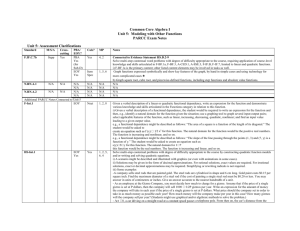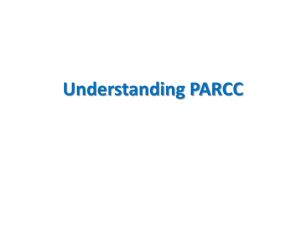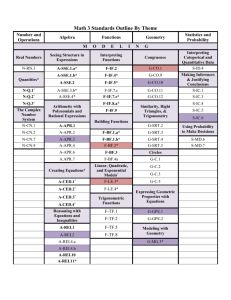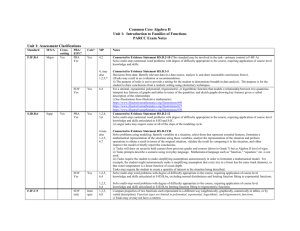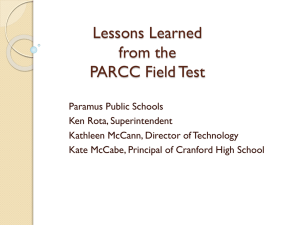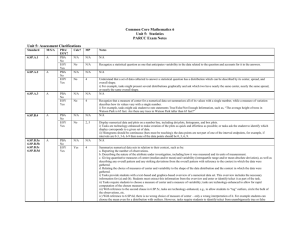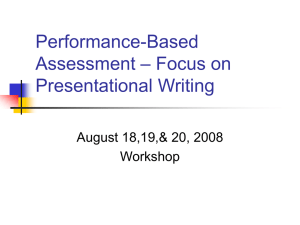04 CC Alg 1 Unit 2 PARCC info
advertisement
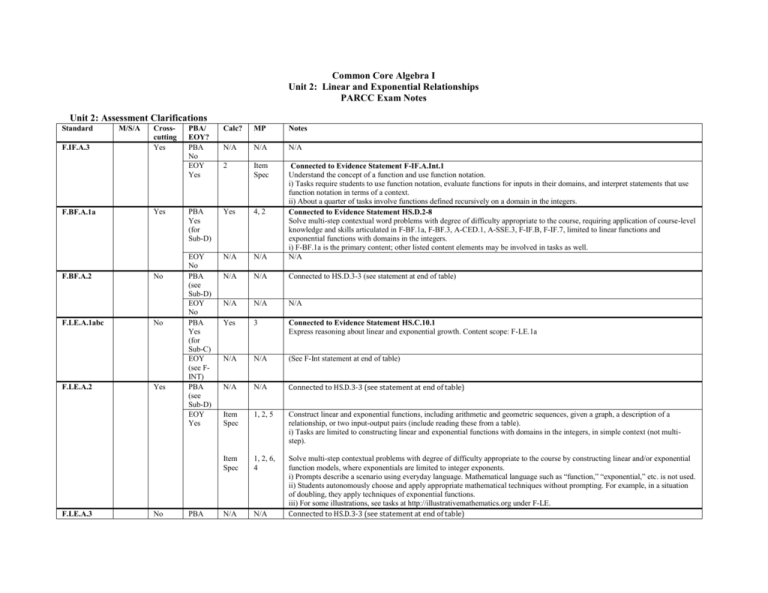
Common Core Algebra I Unit 2: Linear and Exponential Relationships PARCC Exam Notes Unit 2: Assessment Clarifications Standard F.IF.A.3 F.BF.A.1a F.BF.A.2 F.LE.A.1abc F.LE.A.2 F.LE.A.3 M/S/A Crosscutting Yes Yes No No Yes No PBA/ EOY? PBA No EOY Yes Calc? MP Notes N/A N/A N/A 2 Item Spec PBA Yes (for Sub-D) Yes 4, 2 EOY No PBA (see Sub-D) EOY No PBA Yes (for Sub-C) EOY (see FINT) PBA (see Sub-D) EOY Yes N/A N/A Connected to Evidence Statement F-IF.A.Int.1 Understand the concept of a function and use function notation. i) Tasks require students to use function notation, evaluate functions for inputs in their domains, and interpret statements that use function notation in terms of a context. ii) About a quarter of tasks involve functions defined recursively on a domain in the integers. Connected to Evidence Statement HS.D.2-8 Solve multi-step contextual word problems with degree of difficulty appropriate to the course, requiring application of course-level knowledge and skills articulated in F-BF.1a, F-BF.3, A-CED.1, A-SSE.3, F-IF.B, F-IF.7, limited to linear functions and exponential functions with domains in the integers. i) F-BF.1a is the primary content; other listed content elements may be involved in tasks as well. N/A N/A N/A Connected to HS.D.3-3 (see statement at end of table) N/A N/A N/A Yes 3 Connected to Evidence Statement HS.C.10.1 Express reasoning about linear and exponential growth. Content scope: F-LE.1a N/A N/A (See F-Int statement at end of table) N/A N/A Connected to HS.D.3-3 (see statement at end of table) Item Spec 1, 2, 5 Construct linear and exponential functions, including arithmetic and geometric sequences, given a graph, a description of a relationship, or two input-output pairs (include reading these from a table). i) Tasks are limited to constructing linear and exponential functions with domains in the integers, in simple context (not multistep). Item Spec 1, 2, 6, 4 N/A N/A Solve multi-step contextual problems with degree of difficulty appropriate to the course by constructing linear and/or exponential function models, where exponentials are limited to integer exponents. i) Prompts describe a scenario using everyday language. Mathematical language such as “function,” “exponential,” etc. is not used. ii) Students autonomously choose and apply appropriate mathematical techniques without prompting. For example, in a situation of doubling, they apply techniques of exponential functions. iii) For some illustrations, see tasks at http://illustrativemathematics.org under F-LE. Connected to HS.D.3-3 (see statement at end of table) PBA F.IF.B.4 F.IF.B.5 F.IF.B.6 Yes No Yes (see Sub-D) EOY (see FINT) PBA No EOY Yes PBA No EOY Yes PBA Yes EOY Yes F.IF.C.7ae No PBA Yes N/A N/A (See F-Int statement at end of table) N/A N/A N/A Item Spec 6, 4 N/A N/A For a linear or quadratic function that models a relationship between two quantities, interpret key features of graphs and tables in terms of the quantities, and sketch graphs showing key features given a verbal description of the relationship. Key features include: intercepts; intervals where the functions is increasing, decreasing, positive, or negative; relative maximums and minimums; end behavior; and symmetries. i) See illustrations for F-IF.4 at http://illustrativemathematics.org, e.g., http://illustrativemathematics.org/illustrations/649, http://illustrativemathematics.org/illustrations/637, http://illustrativemathematics.org/illustrations/639 N/A Neut 2 Relate the domain of a function to a graph and, where applicable, to the quantitative relationship it describes, limiting to linear functions, square root functions, cube root functions, piecewise-defined functions (including step functions and absolute-value functions), and exponential functions with domains in the integers. For example, if the function h(n) gives the number of personhours it takes to assemble n engines in a factory, then the positive integers would be an appropriate domain for this function. i) Tasks have a real-world context. Neut 2 Item Spec 1, 4, 5, 7 Relate the domain of a function to a graph and, where applicable, to the quantitative relationship it describes, limiting to quadratic functions. i) Tasks have a real-world context. Calculate and interpret the average rate of change of a function (presented symbolically or as a table) over a specified interval with functions limited to square root functions, cube root functions, and piecewise-defined (including step functions and absolute value functions) functions with domains in the integers. ★ i) Tasks have a context. Item Spec 1, 4, 5, 7 Item Spec 1, 4, 5, 7 Item Spec 1, 4, 5, 7 Item Spec 1, 5, 6 Estimate the rate of change from a graph utilizing linear functions, quadratic functions, square root functions, cube root functions, piecewise-defined functions (including step functions and absolute value functions), and/or exponential functions with domains in the integers.★ i) Tasks have a context. Calculate and interpret the average rate of change of a function (presented symbolically or as a table) over a specified interval with functions limited to square root functions, cube root functions, and piecewise-defined (including step functions and absolute value functions) functions with domains in the integers. ★ i) Tasks have a context. Estimate the rate of change from a graph utilizing linear functions, quadratic functions, square root functions, cube root functions, piecewise-defined functions (including step functions and absolute value functions), and/or exponential functions with domains in the integers.★ i) Tasks have a context. Graph functions expressed symbolically and show key features of the graph, by hand in simple cases and using technology for more complicated cases.★ a) Graph linear functions and show intercepts. F.IF.C.9 F.BF.B.3 F.LE.B.5 S.ID.C.9 S.ID.B.6abc S.ID.C.7 Yes Yes Yes No Yes No EOY Yes Item Spec 1, 5, 6 Graph functions expressed symbolically and show key features of the graph, by hand in simple cases and using technology for more complicated cases.★ a) Graph linear functions and show intercepts. PBA No EOY Yes N/A N/A N/A Item Spec 1, 3, 5, 6, 8 PBA Yes (for Sub-C and Sub-D) Yes 3 Compare properties of two functions each represented in a different way (algebraically, graphically, numerically in tables, or by verbal descriptions). For example, given a graph of one quadratic function and an algebraic expression for another, say which has the larger maximum. Function types should be limited to linear functions, quadratic functions, square root functions, cube root functions, piecewise-defined functions (including step functions and absolute value functions), and exponential functions with domains in the integers. i) Tasks may or may not have a context. Connected to Evidence Statement HS.C.9.1 Express reasoning about transformations of functions. Content Scope: F.BF.3, limited to linear and quadratic functions. Tasks will not involve ideas of even or odd functions. Yes 4, 2 EOY Yes Item Spec 3, 5, 7 Item Spec 5, 3, 8 PBA (see Sub-D) EOY (see FINT) PBA No EOY Yes N/A N/A Identify the effect on the graph of r specific values of k (both positive and negative); find the value of k given the graphs limiting the function types to linear and quadratic functions. i) Illustrating an explanation is not assessed here. (See Sub-claim C on the PBA) Connected to HS.D.3-3 (see statement at end of table) N/A N/A (See F-Int statement at end of table) N/A N/A N/A Yes 1, 2, 5, 6, 4 PBA No EOY Yes N/A N/A Connected to Evidence Statement S-ID.Int.1 Solve multi-step contextual word problems with degree of difficulty appropriate to the course, requiring application of course-level knowledge and skills articulated in S-ID, limiting function fitting to linear functions and exponential functions with domains in the integers. N/A Yes 1, 2, 5, 6, 4 PBA No N/A N/A Connected to Evidence Statement HS.D.2-8 Solve multi-step contextual word problems with degree of difficulty appropriate to the course, requiring application of course-level knowledge and skills articulated in F-BF.1a, F-BF.3, A-CED.1, A-SSE.3, F-IF.B, F-IF.7, limited to linear functions and exponential functions with domains in the integers. i) F-BF.1a is the primary content; other listed content elements may be involved in tasks as well. specific values of k (both positive and negative); find the value of k given the graphs limiting the function types to linear and quadratic functions. i) Tasks do not involve recognizing even and odd functions. ii) Experimenting with cases and illustrating an explanation are not assessed here. Connected to Evidence Statement S-ID.Int.1 Solve multi-step contextual word problems with degree of difficulty appropriate to the course, requiring application of course-level knowledge and skills articulated in S-ID, limiting function fitting to linear functions and exponential functions with domains in the integers. N/A S.ID.C.8 A.REI.C.5 A.REI.C.6 A.REI.D.11 A.REI.D.12 No No Yes Yes No EOY Yes Yes 1, 2, 5, 6, 4 PBA No EOY Yes N/A N/A Yes 1, 2, 5, 6, 4 PBA Yes (for Sub-C) EOY No PBA Yes (for Sub-C) EOY Yes Yes 3 N/A N/A N/A Yes 6 Connected to Evidence Statement HS.C.16.2 Given an equation or system of equations, present the solution steps as a logical argument that concludes with the set of solutions (if any). Tasks are limited to quadratic equations. Content Scope: A. REI.1, A-REI.4a, A-REI.4b, limited to real solutions only Item Spec 1, 2, 4 PBA Yes Item Spec 1, 5 Solve multi-step contextual problems that require writing and analyzing systems of linear equations exactly and approximately (e.g., with graphs), focusing on pairs of linear equations in two variables. i) Tasks have hallmarks of modeling as a mathematical practice (less defined tasks, more of the modeling cycle, etc.). ii) Scaffolding in tasks may range from substantial to very little or none. Find the solutions of where the graphs of the equations y = f (x) and y = g(x) intersect, e.g. using technology to graph the functions, make tables of values or find successive approximations. Limit f (x) and/or g(x) to linear and quadratic functions.★ i) The “explain” part of standard A.REI.11 is not assessed here. For this aspect of the standard, see Sub-claim C. Yes 3 Yes 3 Yes 4, 2 EOY Yes Yes 1, 5 PBA Yes No 1, 5, 6 Connected to Evidence Statement S-ID.Int.1 Solve multi-step contextual word problems with degree of difficulty appropriate to the course, requiring application of course-level knowledge and skills articulated in S-ID, limiting function fitting to linear functions and exponential functions with domains in the integers. N/A Connected to Evidence Statement S-ID.Int.1 Solve multi-step contextual word problems with degree of difficulty appropriate to the course, requiring application of course-level knowledge and skills articulated in S-ID, limiting function fitting to linear functions and exponential functions with domains in the integers. Connected to Evidence Statement HS.C.5.6 Given an equation or system of equations, reason about the number or nature of the solutions. Content Scope: A.REI.5 Connected to Evidence Statement HS.C.5.10-1 Given an equation or system of equations, reason about the number or nature of the solutions. Content Scope: A-REI.11 limited to equations of the form f (x) = g(x) where f and g are linear or quadratic. Connected to Evidence Statement HS.C.6.1 Base explanations/reasoning on the principle that the graph of an equation in two variables is the set of all its solutions plotted in the coordinate plane. Content Scope: A-REI.D excluding exponential and logarithmic functions. Connected to Evidence Statement HS.D.2-5 Solve multi-step contextual word problems with degree of difficulty appropriate to the course, requiring application of course-level knowledge and skills articulated in A-CED, N-Q, A-SSE.3, A-REI.6, A-REI.12, A-REI.11-2, limited to linear equations and exponential equations with integer exponents. i) A-CED is the primary content; other listed content elements may be involved in tasks as well. Find the solutions of where the graphs of the equations intersect, e.g., using technology to graph the functions, make tables of values, or find successive approximations. Limit f(x)and/or g(x)to polynomial functions.★ i) The “explain” part of standard A-REI.11 is not assessed here. For this aspect of the standard, see Sub-claim C on the PBA. ii) Polynomials are of degree two and higher. Graph the solutions to a linear inequality in two variables as a half-plane (excluding the boundary in the case of a strict inequality), and graph the solution set to a system of linear inequalities in two variables as the intersection of the corresponding half-planes. EOY Yes Additional PARCC Notes Connected to Unti 2 PBA HS.C.18.1 Yes 3 Connected to Evidence Statement HS.C.6.1 Base explanations/reasoning on the principle that the graph of an equation in two variables is the set of all its solutions plotted in the coordinate plane. Content Scope: A-REI.D excluding exponential and logarithmic functions. Yes 4, 2 No 1, 5, 6 Connected to Evidence Statement HS.D.2-6 Solve multi-step contextual word problems with degree of difficulty appropriate to the course, requiring application of course-level knowledge and skills articulated in A-CED, N-Q.2, A-SSE.3, A-REI.6, A-REI.12, A-REI.11-2, limited to linear and quadratic functions. Graph the solutions to a linear inequality in two variables as a half-plane (excluding the boundary in the case of a strict inequality), and graph the solution set to a system of linear inequalities in two variables as the intersection of the corresponding half-planes. Yes 3, 6 4, may also 1, 2, 5, 7 4, may also 1, 2, 5, 7 HS.D.1-1 PBA Yes HS.D.3-1 PBA Yes HS.D.3-3 PBA Yes 4, may also 1, 2, 5, 7 F-Int.1 EOY Neut 1, 2, 8 HS-Int.1 EOY Yes Yes 1, 2, 5, 6, 4 Construct, autonomously, chains of reasoning that will justify or refute propositions or conjectures about linear equations in one or two variables. Content scope: 8.EE.B Solve multi-step contextual problems with degree of difficulty appropriate to the course, requiring application of knowledge and skills articulated in 7.RP.A, 7.NS.3, 7.EE, and/or 8.EE. Micro-models: Autonomously apply a technique from pure mathematics to a real-world situation in which the technique yields valuable results even though it is obviously not applicable in a strict mathematical sense (e.g., profitably applying proportional relationships to a phenomenon that is obviously nonlinear or statistical in nature). Content Scope: Knowledge and skills articulated in A-APR.1-1, A-CED.4-1, A-REI.10, A-REI-11.1a, A-REI.12, A-REI.4b-1, AREI.4b-2, A-SSE.2-1, A- SSE.3a, F-IF.1, F-IF.6-1a, F-IF.6-6a, F-IF.7a-1, F-IF.7a- 2, A-REI, A-APR, N-RN, F-BF, F-LE, F-IF. Reasoned estimates: Use reasonable estimates of known quantities in a chain of reasoning that yields an estimate of an unknown quantity. Content Scope: Knowledge and skills articulated in A-APR.1-1, A-CED.4-1, A-REI.10, A-REI-11.1a, A-REI.12, A-REI.4b-1, AREI.4b-2, A-SSE.2-1, A- SSE.3a, F-IF.1, F-IF.6-1a, F-IF.6-6a, F-IF.7a-1, F-IF.7a- 2, A-REI, A-APR, N-RN, F-BF, F-LE, F-IF. Given a verbal description of a linear or quadratic functional dependence, write an expression for the function and demonstrate various knowledge and skills articulated in the Functions category in relation to this function. i) Given a verbal description of a functional dependence, the student would be required to write an expression for the function and then, e.g., identify a natural domain for the function given the situation; use a graphing tool to graph several input-output pairs; select applicable features of the function, such as linear, increasing, decreasing, quadratic, nonlinear; and find an input value leading to a given output value. e.g., a functional dependence might be described as follows: “The area of a square is a function of the length of its diagonal.” The student would be asked to function. The natural domain for the function would be the positive real numbers. The function is increasing and nonlinear, and so on. e.g., a functional dependence might be described as follows: “The slope of the line passing through the points (1, 3) and (7, y) is a function of y.” The student would be asked to create an equation such as this function. The natural domain this function would be the real numbers. The function is increasing and linear, and so on. Solve multi-step contextual problems with degree of difficulty appropriate to the course by constructing quadratic function models and/or writing and solving quadratic equations. i) A scenario might be described and illustrated with graphics (or even with animations in some cases). ii) Solutions may be given in the form of decimal approximations. For rational solutions, exact values are required. For irrational solutions, exact or decimal approximations may be required. Simplifying or rewriting radicals is not required. iii) Some examples: -A company sells steel rods that are painted gold. The steel rods are cylindrical in shape and 6 cm long. Gold paint costs $0.15 per square inch. Find the maximum diameter of a steel rod if the cost of painting a single steel rod must be $0.20 or less. You may answer in units of centimeters or inches. Give an answer accurate to the nearest hundredth of a unit. - As an employee at the Gizmo Company, you must decide how much to charge for a gizmo. Assume that if the price of a single gizmo is set at P dollars, then the company will sell the company will take in each year if the price of a single gizmo is set at P dollars. What price should the company set in order to take in as much money as possible each year? How much money will the company make per year in this case? How many gizmos will the company sell per year? (Students might use graphical and/or algebraic methods to solve the problem.) lephone pole. From then on, the car’s distance from the he road, driving in the same direction, initially 90 m ahead of the car. From then on, the motorcycle’s distance from the telephone pole is t is in seconds and M is in meters. At what time t does the car catch up to the motorcycle? Find the answer by setting C and M equal. How far are the car and the motorcycle from the telephone pole when this happens? (Students might use graphical and/or algebraic methods to solve the problem.) Solve multi-step mathematical problems with degree of difficulty appropriate to the course that require analyzing quadratic functions and/or writing and solving quadratic equations. i) Tasks do not have a context. ii) Exact answers may be required or decimal approximations may be given. Students might choose to take advantage of the graphing utility to find approximate answers or clarify the situation at hand. For rational solutions, exact values are required. For irrational solutions, exact or decimal approximations may be required. Simplifying or rewriting radicals is not required. iii) Some examples: 2 Given the all values of Find a value of c so that the equation 2x2 Solve multi-step contextual word problems with degree of difficulty appropriate to the course, requiring application of course-level knowledge and skills articulated in F-LE, A-CED.1, A-SSE.3, F-IF.B, F-IF.7, limited to linear functions and exponential functions with domains in the integers. i) F-LE is the primary content and at least one of the other listed content elements will be involved in tasks as well. Solve multi-step contextual word problems with degree of difficulty appropriate to the course, requiring application of course-level knowledge and skills articulated in F-LE, A-CED.1, A-SSE.3, F-IF.B, F-IF.7, limited to linear and quadratic functions. i) F-LE is the primary content and at least one of the other listed content elements will be involved in tasks as well. For rational solutions, exact values are required. For irrational solutions, exact or decimal approximations may be required. Simplifying or rewriting radicals is not required. HS-Int.2 EOY Yes Yes 1, 5, 6 HS-Int.3-1 EOY Yes Yes 4, 2 HS-Int.3-2 EOY Yes Yes 4, 2 PBA/ EOY? PBA Yes (for Sub-D) Calc? MP Notes Yes 4, 2 Connected to Evidence Statement HS.D.2-5 Solve multi-step contextual word problems with degree of difficulty appropriate to the course, requiring application of course-level knowledge and skills articulated in A-CED, N-Q, A-SSE.3, A-REI.6, A-REI.12, A-REI.11-2, limited to linear equations and exponential equations with integer exponents. i) A-CED is the primary content; other listed content elements may be involved in tasks as well. Yes 4, 2 N/A N/A Connected to Evidence Statement HS.D.2-6 Solve multi-step contextual word problems with degree of difficulty appropriate to the course, requiring application of course-level knowledge and skills articulated in A-CED, N-Q.2, A-SSE.3, A-REI.6, A-REI.12, A-REI.11-2, limited to linear and quadratic functions. i) A-CED is the primary content; other listed content elements may be involved in tasks as well. N/A Yes 4, 2 Overarching Standards: Standard M/S/A N.Q.A.1 S N.Q.A.2 S Crosscutting No Yes EOY No PBA Yes (for Connected to Evidence Statement HS.D.2-5 Solve multi-step contextual word problems with degree of difficulty appropriate to the course, requiring application of course-level knowledge and skills articulated in A-CED, N-Q, A-SSE.3, A-REI.6, A-REI.12, A-REI.11-2, limited to linear equations and Sub-D) N.Q.A.3 S No EOY No PBA Yes (for Sub-D) EOY No exponential equations with integer exponents. i) A-CED is the primary content; other listed content elements may be involved in tasks as well. Yes 4, 2 N/A N/A Yes 4, 2 Connected to Evidence Statement HS.D.2-5 Solve multi-step contextual word problems with degree of difficulty appropriate to the course, requiring application of course-level knowledge and skills articulated in A-CED, N-Q, A-SSE.3, A-REI.6, A-REI.12, A-REI.11-2, limited to linear equations and exponential equations with integer exponents. i) A-CED is the primary content; other listed content elements may be involved in tasks as well. Yes 4, 2 N/A N/A Connected to Evidence Statement HS.D.2-6 Solve multi-step contextual word problems with degree of difficulty appropriate to the course, requiring application of course-level knowledge and skills articulated in A-CED, N-Q.2, A-SSE.3, A-REI.6, A-REI.12, A-REI.11-2, limited to linear and quadratic functions. i) A-CED is the primary content; other listed content elements may be involved in tasks as well. N/A Connected to Evidence Statement HS.D.2-6 Solve multi-step contextual word problems with degree of difficulty appropriate to the course, requiring application of course-level knowledge and skills articulated in A-CED, N-Q.2, A-SSE.3, A-REI.6, A-REI.12, A-REI.11-2, limited to linear and quadratic functions. i) A-CED is the primary content; other listed content elements may be involved in tasks as well. N/A PARCC Abbreviation Key: PBA: Performance-Based Assessment EOY: End of Year Assessment M/S/A: Indicates whether this standard is considered Major content, Supporting Content, or Additional Content MP: Standards for Mathematical Practice * Indicates a modeling standard PARCC Sub-Claims: Sub-Claim A: Information on how PARCC will assess major content Sub-Claim B: Information on how PARCC will assess additional and supporting content Sub-Claim C: Information on how PARCC will assess reasoning Sub-Claim D: Information on how PARCC will assess modeling

